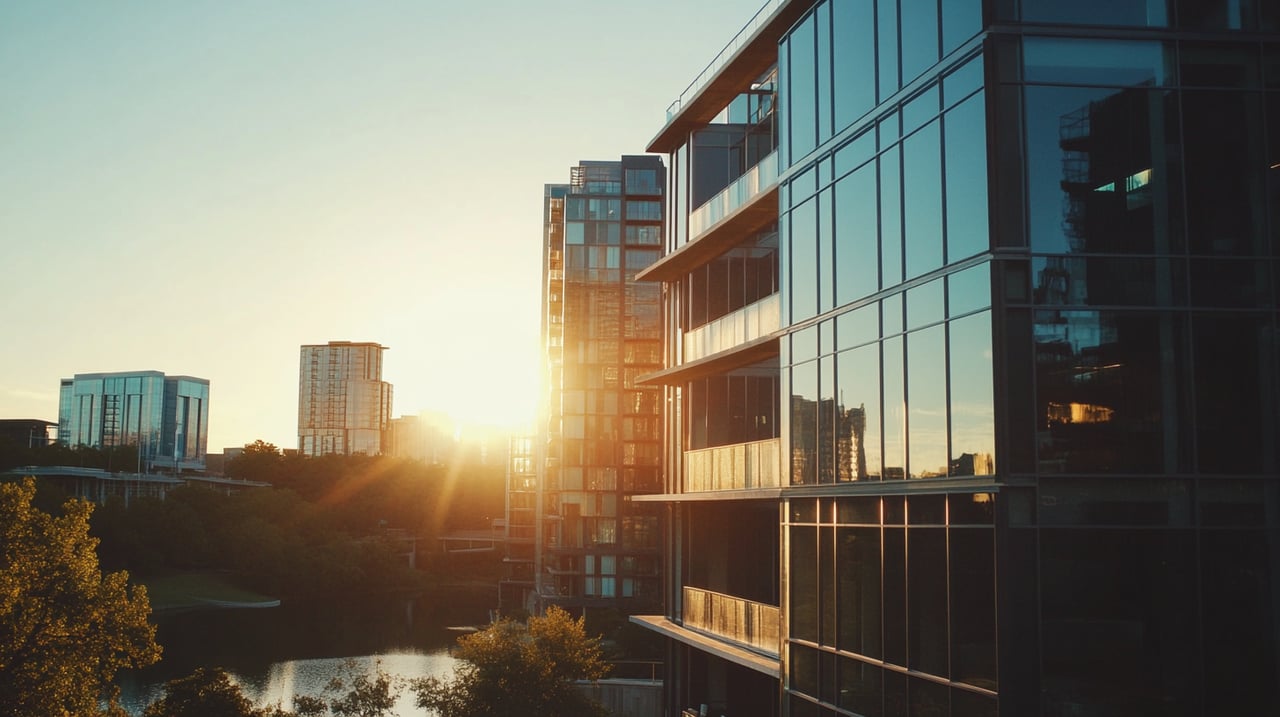As a seasoned real estate professional in Austin's dynamic market, I've spent years helping investors navigate the complexities of property investment in our rapidly growing city. In this comprehensive analysis, I'll break down the current state of Austin's real estate investment landscape, backed by detailed market data and practical insights from years of hands-on experience in this unique market.
The Current State of Austin's Real Estate Market
Austin's real estate market continues to evolve, presenting both opportunities and challenges for investors. Let's dive into the current market conditions and what they mean for potential investors.
Market Performance Overview
As of Q4 2023, Austin's residential real estate market shows strong fundamentals despite some normalization from the peak prices of 2022. The median home price stands at $542,000, representing a 45.3% increase from 2019. Key metrics paint a picture of a maturing market:
- Median Days on Market: 48 days (up from 20 days in 2022)
- Average Price per Square Foot: $265
- Year-over-Year Price Changes: +3.2%
- Sales-to-List Price Ratio: 97.2%
- Housing Inventory: 2.8 months (balanced market range: 4-6 months)
Economic Drivers Fueling Growth
Austin's robust economic foundation continues to drive real estate demand. The city's impressive economic indicators include:
- Unemployment Rate: 3.2% (compared to national average of 3.7%)
- Annual Job Growth Rate: 3.8%
- Median Household Income: $76,925 (14.2% above national average)
- Population Growth: 2.7% annually
- Major Tech Employers: Over 7,200 technology companies
- Average Tech Salary: $125,000
The presence of major employers like Tesla, Apple, Google, and AMD continues to expand, with over 20,000 new tech jobs announced for the next three years. This corporate growth directly impacts housing demand across all price points.
Investment Performance by Property Type
Understanding the performance metrics of different property types is crucial for making informed investment decisions. Let's examine each category in detail.
Land Investment Opportunities
Raw land investment in Austin presents unique opportunities:
- Annual Appreciation: 12.4% (2019-2023)
- Median Price Per Acre:
- Central Austin: $850,000-$1.2M
- Suburban Areas: $125,000-$450,000
- Development-Ready Parcels: $1.5M-$3M
Development considerations include:
- Average Time to Entitlement: 12-18 months
- Infrastructure Costs: $15-25 per sq ft
- Utility Connections: $50,000-$150,000 per acre
- Permitting: 3-5% of project cost
Single-Family Home Investment Performance
The single-family home sector continues to be a strong performer in Austin's market.
New Construction:
- Build Cost: $185-$225 per sq ft
- Developer Margin: 18-22%
- Completion Timeline: 8-12 months
- Absorption Rate: 2.8 homes per month
- Price Premium vs Existing: 15-20%
Existing Homes:
- Average ROI: 8-12% annually
- Cash-on-Cash Return: 5.8-7.2%
- Average Monthly Rent: $2,450
- Annual Maintenance: $5,800
- Insurance Costs: $2,400-$3,200 annually
- Property Tax Rate: 2.17%
Condominium Market Analysis
High-Rise Properties:
- Price Per Sq Ft: $525
- HOA Fees: $0.55-$0.75 per sq ft monthly
- Rental Yield: 4.2-5.1%
- Annual Appreciation: 5.8%
- Special Assessment Frequency: Every 4-6 years
- Average Assessment Cost: $8,500
Mid-Rise/Garden Style:
- Price Per Sq Ft: $385
- HOA Fees: $0.35-$0.45 per sq ft monthly
- Rental Yield: 5.0-6.2%
- Annual Appreciation: 6.2%
- Maintenance Reserve: $3,500 annually
- Average Vacancy Period: 25 days
Commercial Property Insights
Office Space:
- Class A Cap Rates: 5.8-6.5%
- Class B Cap Rates: 6.5-7.2%
- Average Lease Term: 5.2 years
- Tenant Improvement Allowance: $45-65 per sq ft
- Operating Expenses: $12-15 per sq ft annually
- Vacancy Rates: 15.2%
Retail Properties:
- Strip Center Cap Rates: 6.0-6.8%
- Power Center Cap Rates: 5.8-6.5%
- Triple Net Lease Rate: $25-35 per sq ft
- Common Area Maintenance: $5-8 per sq ft
- Tenant Retention: 75%
- Market Vacancy: 4.8%
Understanding Market Risks and Mitigation Strategies
Successful real estate investment requires a thorough understanding of potential risks and how to manage them effectively.
Economic Vulnerability Assessment
Austin's market shows strong fundamentals but has specific risk factors to consider:
- Job Sector Diversity Index: 0.82 (1.0 = perfectly diverse)
- Tech Sector Dependency: 28% of office jobs
- Population Growth Sustainability: 92% confidence level
- Market Cycle Position: Mid-expansion phase
- Interest Rate Sensitivity: Moderate (7.2 on 10-point scale)
Property-Specific Risk Factors
Physical property risks in Austin include:
- Insurance Claim Frequency: 1 per 7 years
- Flood Zone Properties: 12% of inventory
- Foundation Issue Probability: 15% (clay soil areas)
- Building Code Compliance Cost: $2,500-5,000 annually
- Environmental Risk Rating: Low-Moderate
Financial Risk Metrics
Understanding financial risks is crucial for investment planning:
- Default Rate on Investment Properties: 1.2%
- Average Debt Service Coverage Ratio: 1.45
- Typical Loan-to-Value Ratios: 65-75%
- Capital Expenditure Requirements:
- Years 1-5: 2% of property value
- Years 6-10: 3.5% of property value
- Years 11-15: 5% of property value
Market Liquidity Analysis
Property liquidity varies significantly by type:
- Average Days to Sale:
- Single Family: 48 days
- Condos: 52 days
- Commercial: 180 days
- Land: 240 days
- Transaction Costs: 6-8% of sale price
- Marketing Period Variance: ±45 days
- Buyer Pool Depth: Strong (8/10 rating)
Investment Strategies for Different Market Segments
Entry-Level Investment Strategy
For investors entering the Austin market, consider these approaches:
- Focus on emerging neighborhoods with strong appreciation potential
- Start with single-family homes or small multi-family properties
- Target properties with value-add opportunities
- Maintain conservative debt-to-equity ratios
- Build relationships with local property managers
Mid-Market Investment Opportunities
Mid-level investors should consider:
- Multi-family properties in established neighborhoods
- Small commercial properties with stable tenants
- Value-add opportunities in Class B properties
- Portfolio diversification across property types
- Strategic use of leverage for expansion
Large-Scale Investment Considerations
For institutional or large-scale investors:
- Class A multi-family developments
- Commercial property portfolios
- Land banking opportunities
- Mixed-use development projects
- Strategic market timing based on economic indicators
Market Outlook and Future Trends
Short-Term Projections (12-24 Months)
The Austin market shows several key trends:
- Continued population growth driving housing demand
- Normalization of price appreciation rates
- Increasing importance of location selection
- Growing emphasis on property condition and amenities
- Rising interest in sustainable and energy-efficient properties
Long-Term Market Potential
Looking ahead 5-10 years:
- Sustained job market growth from tech sector expansion
- Infrastructure improvements increasing property values
- Emerging submarkets creating new opportunities
- Evolving tenant preferences shaping property features
- Environmental considerations affecting development
Investment Success Factors
Key Elements for Success
- Location Selection:
- Proximity to employment centers
- Access to transportation
- Quality of local amenities
- Future development plans
- School district performance
- Property Management:
- Professional property management
- Preventive maintenance programs
- Tenant screening processes
- Regular market rate analysis
- Emergency response protocols
- Financial Management:
- Conservative leverage ratios
- Adequate cash reserves
- Regular financial review
- Tax planning strategies
- Insurance coverage optimization
Conclusion
Austin's real estate market continues to offer strong investment potential, supported by robust economic fundamentals and sustained population growth. While each property type presents unique opportunities and challenges, success in this market requires careful analysis, strategic planning, and professional guidance.
The key to successful real estate investment in Austin lies in understanding the market's dynamics, recognizing risk factors, and implementing appropriate mitigation strategies. Whether you're considering your first investment property or expanding your portfolio, professional guidance can help you maximize returns while managing risks effectively.
As your local real estate consultant, I'm here to help you navigate Austin's investment opportunities. The data presented in this analysis provides a foundation for making informed investment decisions, but each investment should be evaluated based on individual circumstances and goals.
Next Steps for Investors
- Assess your investment goals and risk tolerance
- Identify target property types and locations
- Develop a financial strategy and funding sources
- Build a professional team (realtor, lender, property manager)
- Create a detailed investment plan with clear metrics
Ready to explore specific investment opportunities in Austin? Contact me for a personalized consultation and detailed market analysis tailored to your investment goals. Let's work together to build a successful real estate investment strategy that aligns with your objectives and leverages Austin's strong market fundamentals.
Remember, successful real estate investment is a journey that requires patience, diligence, and expert guidance. By staying informed about market conditions and working with experienced professionals, you can maximize your chances of success in Austin's dynamic real estate market.





